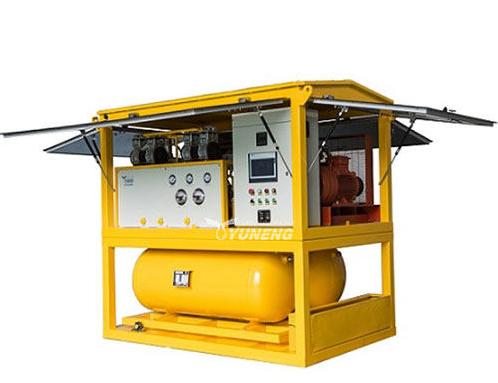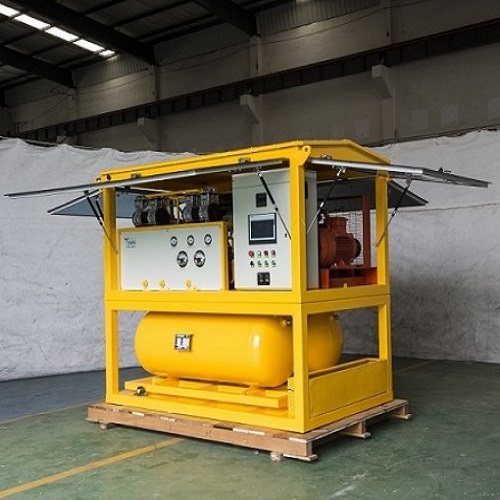SF6 Gas Filling Equipment in Electrical Systems
Sulfur hexafluoride (SF6) gas, with its exceptional insulating and arc-suppressing properties, forms the lifeblood of high-voltage electrical systems. Yet, maintaining its optimal performance demands intricate interplay between the gas itself and specialized equipment used for replenishment. Let’s delve deeper into the world of SF6 gas filling equipment, exploring its functions, variations, and crucial considerations for ensuring efficient and responsible gas level management.
The Importance of SF6 Gas Filling
Sulfur hexafluoride (SF6) gas plays a vital role in ensuring the safe and reliable operation of high-voltage electrical equipment, particularly circuit breakers and switchgear. Its exceptional insulating and arc-quenching properties make it the preferred choice for preventing electrical faults and maintaining system stability. However, maintaining optimal SF6 gas levels is crucial for its effectiveness, necessitating a specialized process known as SF6 gas filling.

Why Proper SF6 Gas Filling Matters:
- Ensures Effective Insulation: Over time, natural decomposition and leaks can cause SF6 levels to deplete, compromising its insulating properties. This can lead to arcing, electrical overloads, and equipment damage. Proper gas filling restores optimal insulation, preventing such issues and ensuring safe operation.
- Extends Equipment Life: Maintaining adequate SF6 levels reduces stress on electrical components, prolonging their lifespan and minimizing maintenance costs.
- Improves Efficiency: Optimal SF6 levels ensure efficient operation of high-voltage equipment, minimizing energy losses and contributing to cost savings.
- Enhances Safety: By preventing electrical faults and arcing, proper SF6 gas filling reduces the risk of electrical accidents and ensures operator safety.
What is SF6 Gas Filling Equipment
Sulfur hexafluoride (SF6) gas is a vital component in high-voltage electrical equipment, it acts as an exceptional insulator and arc suppressant. Maintaining optimal SF6 levels is crucial for the safe and reliable operation of these systems, and that’s where SF6 gas filling equipment comes in.
Key Components of SF6 Gas Filling Equipment
- SF6 Cylinders: These high-pressure containers store the gas and feature valves and gauges for controlled dispensing. Think of them as the gas tanks of the electrical world, holding the precious SF6 reserves.
- Regulators and Flow Meters: These devices precisely manage the gas pressure and flow rate during filling, ensuring safe and accurate delivery. Imagine them as the traffic lights and speedometers of the gas flow, keeping everything running smoothly.
- Vacuum Pumps and Gauges: Before introducing fresh gas, a vacuum is created within the equipment to remove any contaminants or moisture that could compromise the SF6’s insulating properties. Think of them as powerful vacuum cleaners, preparing a clean canvas for the gas to work its magic.
- Hoses and Couplings: These leak-proof connections transfer the gas from cylinders to equipment, minimizing emissions and ensuring every molecule reaches its destination. Imagine them as the sturdy pipes of the gas delivery system, ensuring a safe and efficient transfer.
- Control Panels and Safety Features: Modern systems boast intelligent control panels that monitor pressure, flow rate, and potential leaks. Safety features like pressure relief valves and leak detectors act as vigilant guardians, preventing accidents and minimizing environmental impact. Think of them as the watchful eyes and safety alarms of the operation.

Common Types of SF6 Gas Filling Equipment
Here are some different types of SF6 gas filling equipment for every specific need:
The management of sulfur hexafluoride (SF6) gas in electrical systems demands a nuanced approach, with different types of gas filling equipment catering to various operational requirements. Here, we delve into three distinct categories, each designed to address specific needs within the intricate landscape of SF6 gas handling.
1. Mobile SF6 Gas Filling Carts
Mobile service carts stand out as compact and portable systems tailored for on-site maintenance and refilling operations. These carts are equipped with the necessary components for gas recovery, purification, and precise filling. Ideal for scenarios requiring quick and convenient gas replenishment across various locations due to their portability. Well-suited for occasional maintenance tasks and situations where flexibility is paramount.
The key advantages lie in their flexibility and ease of movement, allowing technicians to navigate different sections of a facility or travel to remote sites effortlessly. However, these carts come with limited capacity, making them less suitable for high-volume filling operations where a larger reservoir may be required.
2. Stationary SF6 Gas Filling Stations:
Stationary filling stations represent larger and more robust systems designed for high-volume filling needs, often found in manufacturing facilities or substations. These stations provide increased control over gas delivery. Particularly efficient for large-scale operations that demand precise and high-capacity gas delivery. They excel in frequent or bulk filling scenarios, offering stability and control over the filling process.
The primary advantages lie in their high capacity, making them ideal for situations requiring frequent or bulk filling operations. They provide a fixed and stable solution for continuous gas supply. On the flip side, these filling stations are less flexible than their mobile counterparts. They require fixed installations, making them less suitable for applications demanding constant mobility. Additionally, the initial investment is generally higher.

3. Automated SF6 Gas Filling Systems:
Automated filling systems represent the pinnacle of SF6 gas handling technology, utilizing computer-controlled valves and sensors for precision and consistency in gas delivery. Suited for complex operations where maintaining consistency and minimizing human error are critical. Often deployed in high-volume settings, ensuring efficiency and accuracy in large-scale applications.
Automated systems offer significant advantages by minimizing human error, ensuring consistent precision in gas filling, and providing automated monitoring and control. However, these advanced systems come with a higher initial investment, requiring specialized training for operation. While immensely effective in large-scale operations, they may not be cost-effective for smaller-scale applications.
In general, the diverse landscape of SF6 gas filling equipment caters to the varied needs of the electrical industry. Whether prioritizing mobility, high capacity, or automated precision, these different types of equipment play a crucial role in maintaining the integrity and efficiency of electrical systems relying on SF6 gas.
YUNENG’s Advantage of Its SF6 Gas Filling Equipment
The YUNENG QTHS SF6 gas-filling equipment is designed to efficiently recover, purify, and fill SF6 gas within Gas Insulated Switchgear (GIS) or other insulated electrical equipment. This comprehensive system includes essential components such as the SF6 compressor, vacuum pump, anti-oil return device-equipped vacuum system, condensation system, liquid storage tank, built-in renewable dry filter for purification, dust filter, ball valve, vacuum gauge, electrical control, pressure detection and alarm devices, instrument panels, and other auxiliary facilities. Capable of vacuuming, filling, recovering, and storing SF6 gas, this equipment ensures a thorough and precise handling process.
At YUNENG, customer satisfaction is a top priority, and we offer the flexibility to customize the machine according to specific requirements, providing tailored solutions to meet the diverse needs of our clients.
If you have any interest in our products, please feel free to contact us.

